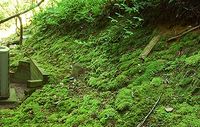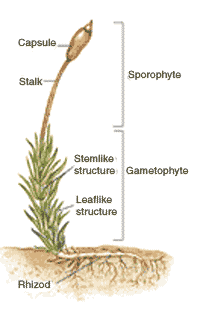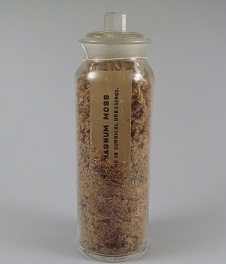Moss
Overview

Moss is a group of plants that belong to the division Bryophyta. Moss offers a food source and habitat for invertebrates that help soil
Structure of moss

- Moss lacks vascular tissue, which is what other plants use to transport water and nutrients throughout them. Because they lack this tissue, they do not have flowers, roots, or stems. Instead, it has rhizoids, which act like roots holding the cluster in place.
Life Cycle
- Moss have two parts to their life cycle. The first part, called sporophyte, is the stage where spores are produced. The spores are carried by wind to populate other areas. The second stage, called gametophyte, is after the spores found a place to grow. They develop male and female sex organs, which allow for reproduction. The male sex organ is an umbrella shaped antheridial head, which contains sperm. The female sex organ is called an archegonial head, which is looks like little fingers, and each finger contains one egg. When it rains, the water splashes the sperm onto the eggs, and the eggs become fertilized.
Environmental Role
Mosses play an important part in stabilizing soil, and reducing erosion. They have the ability to retain a lot of water, so they create humid environments in which other plants can flourish more easily.
In addition, some types, such as peat moss, are added to fertilizer for plant nutrition. Peat mosses are found throughout the northeastern wetland areas, and are what makes up the majority of bogs. Peat mosses are an important source of fuel in some countries. Peat is abundant in the northern hemisphere and embodies a vast amount of potential energy. In northern Europe, peat is often dried, and compressed into briquettes for use in fireplaces and stoves. In Ireland, peat is still used often as a heating source to cook with. One great advantage of peat as a fuel is that it burns clean. About 95% of peat harvested in Ireland is burned to generate electricity. Because it has the ability to absorb large amounts of water, peat improves the water-holding capacity when added to soil.
Medical Use
Peat moss is acidic in nature which prevents the growth of a lot of different types of bacteria. Because of this they have been used in many different ways such as diapers and during both world wars, when bandages ran low, peat moss were introduced as a great antiseptic dressing for wounds." As the moss soaks up all the negatively charged nutrients in the soil, it releases positively charged ions that make the environment around it acidic. For wounded humans, the result is that sphagnum bandages produce sterile environments by keeping the pH level around the wound low, and inhibiting the growth of bacteria."
We know longer use mosses for bandages mostly because it isn't cost effective to dig the stuff up. Which turns out is a good thing because we need mosses to stay where there at. Vast areas full of sphagnum and other types of mosses have been accumulating carbon for thousands of years under the ground and in certain areas if they defrost or dry out, the carbon stores will leak out which would be horrible for climate change.
Sources:
- [1] “Bryophytes.” Prentice Hall Biology, www.jayreimer.com/TEXTBOOK/iText/products/0-13-115516-4/ch22/ch22_s2_1.html.
- [2] Martin, Annie. “5 Environmental Benefits of Moss Gardening.” Timber Press, 9 Sept. 2015, [[1]].
- [3] “Moss.” Basic Biology, 23 May 2015, [[2]].
- [4] “Moss Facts.” Soft Schools, [[3]].
- [5] Stein Carter, J. “Primitive Plants: Mosses, Ferns, and Allies.” Biology Clermont, 11 July 2017, [[4]].
- [6}
